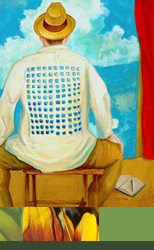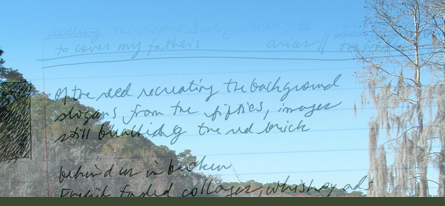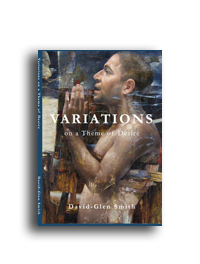

|
|
David-Glen Smith's Variations on a Theme of Desire is equal parts philosophical text, archeological exploration, fairy tale, and map of human memory. It's no surprise a book of such grand scope sees saints of music, poetry, and faith appear in its pages. These are poems of jazz and crow, of the long dead and the just living, of the topography of a dreamscape built from the bones of those who walk, briefly or lingering, across our lives. But perhaps more than anything, this book is a guide written by a poet to his young son, something the boy can tuck away so that one day, when he's ready and capable of understanding, he can read and know the map of his father's heart. How, no matter the songs that play, the lyrics just underneath the melodies say, "Remember, son, in all aspects of this fragmented world—I will never leave you." —Bryan Borland, author of Less Fortunate Pirates |
||||
Variations on a Theme of Desire, David-Glen Smith’s long-awaited first book, is the work of a mature, patient poet. Following in the footsteps of Walt Whitman, Mark Doty, Sylvia Plath, Lynda Hull, among many others, Smith wows the reader with his surprising imagery as he takes us on his erotic journey. In a section of “broken sonnets,” he imagines telling an ex-lover about his current lover, “his beauty is like a fine, dense rain,/as a flood of levees, drowning out the horizon line—“ Yet, he is still haunted by “impressions remaining from fingertips once pressed….The moment still drenches.” Full of Biblical and mythological references, the book’s back and forth movement includes dances with Death, metamorphosis and transcendence, ultimately, acceptance and forgiveness. Its complexity and beauty will entice the reader back again and again. —Joan Seliger Sidney, Body of Diminishing Motion and Bereft and Blessed |
|||||
Press Contact Info: |
|||||
As a Preface: Importance of Fragments
[The following text acts as an introduction to my recently published book Variations on a Theme of Desire. In a semi-formal fashion it address the the structure of a majority of the poems and the mindset which helped generate them.] Poems never emerge in a writer’s head fully formed as a completed, finalized piece of artwork. Rather, poetry often begins with only a single word, a simple image, or a fragmented phrase. Poets manipulate the various fractions of ideas, molding images, words, phrases into fuller art forms, which frequently take on a life of their own. The majority of poems displayed in Variations on a Theme of Desire follow the logic of constructing a large piece of art out of smaller deconstructions of various ideas, utilizing small units of expression, clusters of terse, fragmented lines, momentary expressions and catch phrases—all brought together in order to project a finalized construction. For example, from the opening section of the book, the poem “Venerations of the Temple” specifically holds multiple splinters of thought which follow a similar thread: Thrumming against the glass, a horsefly crosses the window where These fragments show Walt Whitman during, and leading up to, the winter before his death. In the full poem, some lines are loosely based on eyewitness accounts of his last days; other lines are pure creative speculation of events, a blurring of fiction with reality. Likewise, what is also important to keep in mind, a fragmented sentence carries the same beauty as the ruins of an ancient city. Advantages exist for beginning a creative work with textured fractions and broken sentences. This process is much like basic rules of brainstorming and free-writing: no idea is a bad idea, formulate the thought before editing the thought, value quantity over quality. Poetry often survives off abstractions and half-formed impressions. These elements promote mood, formulate style, and instigate diverse interpretations and further discussions. For example, looking at the existing fragments of the Ancient Greek poet Sappho, over time much of her work is limited to partial forms: quotes from other writers, scraps of lines left on papyrus, lingering remnants of larger works copied by hand. Yet, even when reading the shortest of these surviving phrases, a sense of the full poem can be gained, a theme of intense desire can be visualized: “I do not expect/to touch the sky” (No. 8). [2] With these brief eight words, a full theme addressing the intensity of an individual’s desire can be visualized. Another modern example, Lynda Hull uses fragmented imagery throughout her poem “Ornithology.” In this particular case, Hull utilizes various fragments of experience to elaborate a full picture of impression for the persona. Formatted as a modern ode, with intricate placement of jutting lines and tabbed phrases, stanza four and five state: […] Women smoked the boulevards the rumpled musk of lover’s sheets, charred Each stanza merges the persona’s various experiences of urban living as one continuous event, memory blurs with the present now moment of the poem’s telling. The persona, in an act of justification, presents more than one recollection as a means to enhance the full theme of the work. What results: the audience collects supplied phrases and scattered images and reconstructs their own intuitive readings based on what becomes Hull’s multi-layered ode to Charlie “Bird” Parker. Through the use of grounding words such as “boulevards,” “pavement,” “charred/cornices,” and “crosstown gutted buildings,” readers are able to build upon the available components and follow Hull’s concluding message of vitality and passion. One last example comes from Arthur Sze in his book Archipelago. In particular, the poem “The Redshifting Web” is comprised of varying components, diverse patterns, and conflicting objects—building loose connections between numerous subjects and unexpected pairing of articles. In a sense, to develop his themes, Sze mirrors Whitman’s intentions for developing lists and enumerations. For Whitman, these litanies celebrate the Nineteenth Century American experience. These in turn spiral out to provide a suggestion of a Transcendental model for the world to follow. In Sze’s case, his lists follow closer to Zen-inspired themes and analogies. What appears to be at first a casual, fragmented list of ideas is in fact an informal pattern. He writes: The dragons on the back of a circular bronze mirror In the above sample, Sze supplies the reader a variety of images as a means of showing the components of a basic metaphor—then, he steps back. In the fashion of meditation-exercises, he tells the reader, now you build the bridge between the elements. You find the universal connection that exists between these isolated ideas. Both Lynda Hull and Arthur Sze in the end provide unexpected abstractions and controlled abridgements to successfully convey their unique themes and points of view. Their phrasing and line constructions mimic the actual thought process of an individual, moving in a stream-of-conscious fashion from one interior, private reflection to another. Taking this stylistic approach into account, most of the individual poems presented in Variations offer up a broken series of perception for the reader to piece together. Through a poet’s utilization of abstracted strategies, fragments promote a stronger network bond between writer and reader, allowing the respective themes to develop and communicate in an intensified manner. In other words, through the use of fractured imagery and broken observations, a greater sense of empathy towards another’s experience is constructed for the reader, due to the psychological presentation of the character’s motivations and emotional reactions. This in turn enables the possibilities for a greater socializing influence on individuals. Variations on a Theme of Desire insists the fact that with a fragmented text, a stronger analytical approach to the reading process is encouraged for the average reader. |
|||||
References 1. Smith, David-Glen. “Veneration of the Temple: Observations of Whitman in |
|||||
Visit my companion web log, ars longa, vita brevis, for full vita information, displaying the full range of publications from 1985 to the current year. For an occasional, creative outburst, visit:http://twitter.com/davidglensmith
|
|||||

